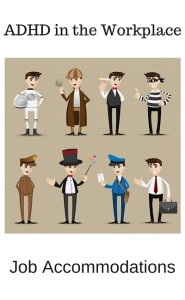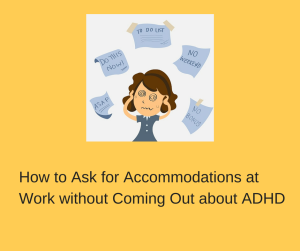Contents [hide]
What is AD/HD?
Attention deficit-hyperactivity disorder (AD/HD) is a neurobehavioral disorder that affects three to five percent of American children and adults. AD/HD is usually diagnosed in childhood, and the condition can continue into the adult years. Many individuals with AD/HD are undiagnosed until adulthood (NINDS, 2011).
The common characteristics of AD/HD are impulsivity, inattention, and/or over-activity (DSM-IV-TR, 2000). Failure to listen to instructions, inability to organize oneself and work tasks, fidgeting with hands and feet, talking too much, inability to stay on task, leaving projects, chores and work tasks unfinished, and having trouble paying attention to and responding to details are the primary symptoms of AD/HD. Although individuals may have both inattention and hyperactivity symptoms, many individuals predominantly display one symptom more than another. Therefore, the DSM-IV-TR identifies three subtypes that can be diagnosed:
- AD/HD predominantly hyperactive-impulsive type: The major characteristics are fidgeting, talking excessively, interrupting others when talking, and impatience.
- AD/HD predominantly inattentive type: The major characteristics are distractibility, organization problems, failure to give close attention to details, difficulty processing information quickly and accurately, and difficulty following through with instructions.
- AD/HD combined type: The individual with combined type meets the criteria for both hyperactive-impulsive and inattentive type.
What causes AD/HD?
Scientists are not sure what causes ADHD, although many studies suggest that genes play a large role. Like many other illnesses, ADHD probably results from a combination of factors. In addition to genetics, researchers are looking at possible environmental factors, and are studying how brain injuries, nutrition, and the social environment might contribute to ADHD (NIMH, 2011).
How is AD/HD treated?
Currently available treatments focus on reducing the symptoms of ADHD and improving functioning. Treatments include medication, various types of psychotherapy, education or training, or a combination of treatments. Much like children with the disorder, adults with ADHD are treated with medication, psychotherapy, or a combination of treatments (NIMH, 2009).
AD/HD and the Americans with Disabilities Act
Is AD/HD a disability under the ADA?
The ADA does not contain a list of medical conditions that constitute disabilities. Instead, the ADA has a general definition of disability that each person must meet (EEOC Regulations . . ., 2011). Therefore, some people with AD/HD will have a disability under the ADA and some will not.
A person has a disability if he/she has a physical or mental impairment that substantially limits one or more major life activities, a record of such an impairment, or is regarded as having an impairment (EEOC Regulations . . . , 2011). For more information about how to determine whether a person has a disability under the ADA, visit http://AskJAN.org/corner/vol05iss04.htm.
Accommodating Employees with AD/HD
Note: People with AD/HD may develop some of the limitations discussed below, but seldom develop all of them. Also, the degree of limitation will vary among individuals. Be aware that not all people with AD/HD will need accommodations to perform their jobs and many others may only need a few accommodations. The following is only a sample of the possibilities available. Numerous other accommodation solutions may exist.
Questions to Consider:
- What limitations does the employee with AD/HD experience?
- How do these limitations affect the employee’s job performance?
- What specific job tasks are problematic as a result of these limitations?
- What accommodations are available to reduce or eliminate these problems? Are all possible resources being used to determine accommodations?
- Can the employee provide information on possible accommodation solutions?
- Once accommodations are in place, can meetings take place to evaluate the effectiveness of the accommodations? Can meetings take place to determine whether additional accommodations are needed?
- Would human resources or personnel departments, supervisors, or coworkers benefit from education, training or disability awareness regarding learning disabilities? Can it be provided?
Accommodation Ideas
Time Management: Individuals with AD/HD may experience difficulty managing time, which can affect their ability to mark time as it passes incrementally by minutes and hours. It can also affect their ability to gauge the proper amount of time to set aside for certain tasks. It may be difficult to prepare for, or to remember, work activities that occur later in the week, month, or year.
- Divide large assignments into several small tasks
- Set a timer to make an alarm after assigning ample time to complete a task
- Provide a checklist of assignments
- Supply an electronic or handheld organizer, and train on how to use effectively
- Use wall calendar to emphasize due dates
- Develop a color-coded system (each color represents a task, or event, or level of importance)
- Allow co-worker or supervisor to add entries on the calendar, or to double-check entries added by the employee with AD/HD
Memory: Individuals with AD/HD may experience memory deficits, which can affect their ability to complete tasks, remember job duties, or recall daily actions or activities.
- Provide written instructions
- Allow additional training time for new tasks
- Offer training refreshers
- Use a flowchart to indicate steps in a task
- Provide verbal or pictorial cues
- Use post-it notes as reminders of important dates or tasks
Concentration: Individuals with AD/HD may experience decreased concentration, which can be attributed to auditory distractions (that can be heard) and/or visual distractions (that can be seen). People with AD/HD report distractions such as office traffic and employee chatter, opening and closing of elevator doors, and common office noises such as fax tones and photocopying.
- To reduce auditory distractions:
- Purchase a noise canceling headset
- Hang sound absorption panels
- Provide a white noise machine
- Relocate employee’s office space away from audible distractions
- Redesign employee’s office space to minimize audible distractions
- To reduce visual distractions:
- Install space enclosures (cubicle walls)
- Reduce clutter in the employee’s work environment
- Redesign employee’s office space to minimize visual distractions
- Relocate employee’s office space away from visual distractions
Organization and Prioritization: Individuals with AD/HD may have difficulty getting or staying organized, or have difficulty prioritizing tasks at work.
- Develop color-code system for files, projects, or activities
- Use weekly chart to identify daily work activities
- Use the services of a professional organizer
- Use a job coach to teach/reinforce organization skills
- Assign a mentor to help employee
- Allow supervisor to assign prioritization of tasks
- Assign new project only when a previous project is complete, when possible
- Provide a “cheat sheet” of high-priority activities, projects, people, etc.
Social Skills: Individuals with AD/HD may have limitations in adaptive skills, such as communicating with others, or exhibiting appropriate social skills. This might manifest itself as interrupting others when working or talking, demonstrating poor listening skills, not making eye contact when communicating, or inability to correctly read body language or understand innuendo.
- Provide a job coach to help understand different social cues
- Identify areas of improvement for employee in a fair and consistent manner
- Make attendance at social activities optional
- Use training videos to demonstrate appropriate behavior in workplace
- Encourage employees to minimize personal conversation or move personal conversation away from work areas
- Provide sensitivity training (disability awareness) to all employees
- Encourage all employees to model appropriate social skills
- Adjust the supervisory method to better fit the employee’s needs
- Allow the employee to work from home
- Adjust method of communication to best suit the employee’s needs
- Use role-play scenarios to demonstrate appropriate behavior in workplace
Hyperactivity/Impulsivity: Individuals with AD/HD Hyperactivity-Impulsive type may exhibit over-activity or impulsive behavior. This could be disruptive to the work environment or could inhibit efficient and effective work performance.
- Provide structured breaks to create an outlet for physical activity
- Utilize a job coach to teach/reinforce techniques to control impulsivity
- Allow the employee to work from home
- Review conduct policy with employee
- Adjust method of supervision to better prepare employee for feedback, disciplinary action, and other communication about job performance
- Use services of EAP
- Provide private workspace where employee will not disturb others by tapping, humming, or fidgeting
Multi-tasking: Individuals with AD/HD may experience difficulty performing many tasks at one time. This difficulty could occur regardless of the similarity of tasks or the frequency of performing the tasks.
- Separate tasks so that each can be completed one at a time
- Create a flowchart of tasks that must be performed at the same time, carefully labeling or color-coding each task in sequential or preferential order
- Provide individualized/specialized training to help employee learn techniques for multi-tasking (e.g., typing on computer while talking on phone)
- Identify tasks that must be performed simultaneously and tasks that can be performed individually
- Provide specific feedback to help employee target areas of improvement
- Remove or reduce distractions from work area
- Supply ergonomic equipment to facilitate multi-tasking
- Clearly represent performance standards such as completion time or accuracy rates
Paperwork: Individuals with AD/HD may experience difficulty completing paperwork efficiently and effectively. This is due in part to workplace distractions and difficulty with time management, disorganization, or prioritization.
- When possible, automate paperwork by creating electronic files
- Use speech recognition software to enter text or data into electronic files
- Save time filling out paper forms by completing information in advance, using pre-filled forms, or adhering pre-printed stickers
- Use checklists in place of writing text
- Supply large quantities of regularly-used forms
- Color-code forms for easy identification
- Re-design commonly used forms
- Use large font
- Double space or triple space
- Provide adequate space for hand-written response
You’ll find more appropriate accommodations in JAN’s article on Executive Function Deficits. http://askjan.org/media/execfunc.html
Attendance: Individuals may have difficulty getting to work promptly because of the varied activities, processes, and interruptions they may experience while preparing to leave their home and/or during their commute.
- Allow flexible work environment:
- Flexible scheduling
- Modified break schedule
- Work from home/Flexi-place
Getting to Work on Time: Employers can have time and attendance standards for all employees. Because getting to work on time is the responsibility of the employee, the following ideas are for employees who are having trouble getting to work on time because of executive function deficits:
- Have a routine of putting and keeping things in their place (keys, phone, glasses)
- Prepare for the next day’s work the night before
- Create a checklist for yourself and others
- Place sticky notes on the door, dashboard, or wherever you will see them
- Turn off distractions – including cell phones
- Set a timer or a programmable watch to pace yourself
Situations and Solutions:
A journalist with AD/HD experienced sensitivity to visual and auditory distractions. The employer provided the individual with a private, high-wall cubicle workspace in a low-traffic area. The employer added an environmental sound machine to mask office noise.
A social worker with AD/HD had difficulty completing handwritten paperwork in a neat and timely fashion. The employer created electronic forms for the employee, which allowed him to type responses. The employer arranged computer files labeled by month to help the employee prioritize open cases. The employer also sent email reminders of deadlines.
An office worker with AD/HD experienced impulsivity and often interrupted co-workers by entering offices without knocking. The employer helped identify appropriate techniques for approaching co-workers, such as keeping a daily list of tasks to discuss with others, then emailing or calling to set aside time to talk about work-related projects.
A retail employee with AD/HD often forgot the closing and cash-out procedures, which resulted in missed printouts of daily sale reports. The employer created a numbered checklist that identified each step for proper closing procedures and identified which reports to run from cash registers. This accommodation benefited all employees.
A delivery person with AD/HD had difficulty with time management. She spent excessive time making deliveries and would forget to return to the warehouse between daily runs. The employer provided a personal organizer watch that could be programmed to beep and display a written message many times throughout the day. This auditory and written prompt helped the employee move quicker from task to task, and helped remind her to return to the warehouse to gather her next load.
A teacher with AD/HD experienced disorganization in her classroom due to clutter from many years of teaching. The employer provided a job coach to help the teacher learn organization techniques, to help separate and store items, and to dispose of previous student work and projects from yesteryear.
Information about JAN
Source – Job Accommodation Network – Accommodation and Compliance Series: Attention Deficit Hyperactivity Disorder, Retrieved December, 6, 2105 from https://askjan.org/media/adhd.html
The Job Accommodation Network is a service of U.S. DOL’s Office of Disability Employment. Article may be reprinted without copyright infringement.
JAN provides free, confidential technical assistance about job accommodations and the Americans with Disabilities Act (ADA).
(800)526-7234 (Voice)
(877)781-9403 (TTY)
Live Help
Email
JAN’s Accommodation and Compliance Series is designed to help employers determine effective accommodations and comply with Title I of the Americans with Disabilities Act (ADA). This information provides a starting point in the accommodation process and may not address every situation. Accommodations should be made on a case by case basis, considering each employee’s individual limitations and accommodation needs.
References
American Psychiatric Association: Diagnosis and Statistical Manual of Mental Disorders, Fourth Edition, Text Revision. Washington, DC, American Psychiatric Association, 2000.
EEOC Regulations To Implement the Equal Employment Provisions of the Americans With Disabilities Act, as Amended, 29 C.F.R. § 1630 (2011).
National Institute of Mental Health (NIMH). (2009). Attention deficit hyperactivity disorder. Retrieved November 17, 2011, fromhttp://www.nimh.nih.gov
National Institute on Neurological Disorders and Stroke (NINDS) (2006). NINDS attention deficit-hyperactivity disorder information page. Retrieved November 17, 2011,from https://www.ninds.nih.gov/disorders/all-disorders/attention-deficit-hyperactivity-disorder-information-page
Updated 03/01/13
“Photo courtesy of iosphere/FreeDigitalPhoto.net” Modified on Canva
Follow ADHD / ADD freeSources’ board ADHD and the Workplace on Pinterest.








